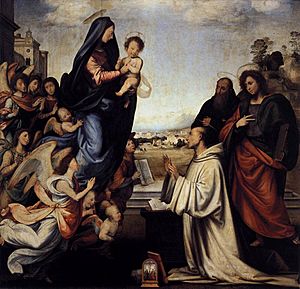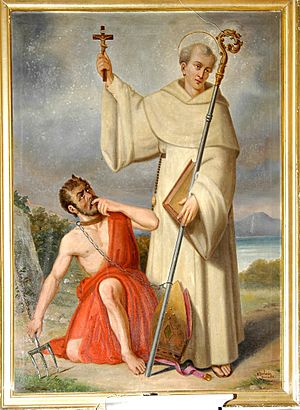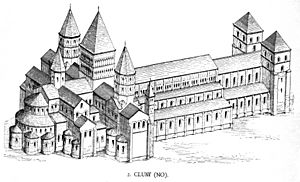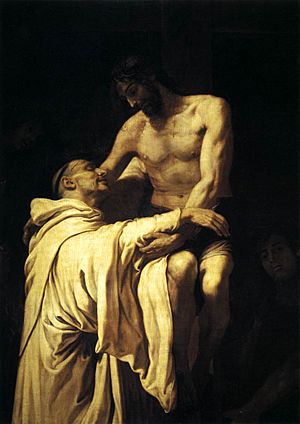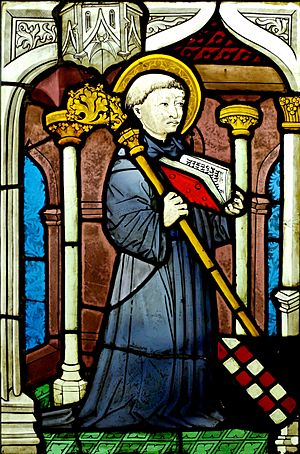Bernard of Clairvaux facts for kids
Quick facts for kids SaintBernard of Clairvaux O. Cist. |
|
|---|---|
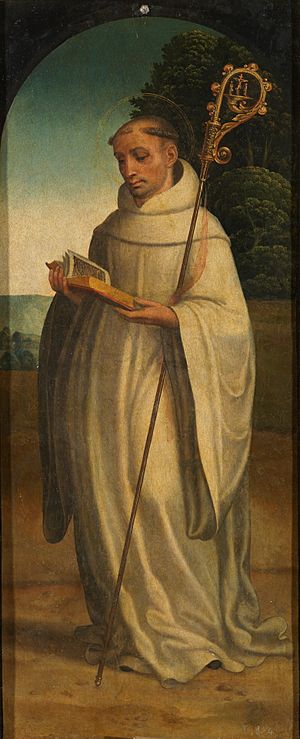
|
|
| Doctor of the Church Doctor Mellifluus Last of the Fathers Confessor Abbot |
|
| Born | c. 1090 Fontaine-les-Dijon, Burgundy, Kingdom of France |
| Died | 20 August 1153 (aged 62-63) Clairvaux Abbey, Clairvaux (modern day part of Ville-sous-la-Ferté), Champagne, Kingdom of France |
| Venerated in | |
| Canonized | 18 January 1174, Rome, Papal States by Pope Alexander III |
| Major shrine | Troyes Cathedral |
| Feast | August 20 |
| Attributes | Cistercian habit, book, and crosier |
| Patronage | Cistercians, Burgundy, beekeepers, candlemakers, Gibraltar, Algeciras, Queens' College, Cambridge, Speyer Cathedral, Knights Templar, Binangonan, Rizal |
Bernard of Clairvaux (born around 1090, died August 20, 1153) is known as Saint Bernard. He was an abbot, a mystic, and helped start the Knights Templar. He also played a big role in changing the Benedictine Order through the new Cistercian Order.
Bernard was sent to create Clairvaux Abbey in a quiet valley in France. In 1128, he helped write the rules for the Knights Templar. These rules soon became a model for Christian knights.
When Pope Honorius II died in 1130, a disagreement about who should be the next pope caused a split in the church. Bernard strongly supported Pope Innocent II. He argued that Innocent was the rightful pope over Antipope Anacletus II.
In 1139, Bernard attended an important church meeting. He spoke out against some of the ideas of Peter Abelard, another famous thinker. Bernard also encouraged many people to join the Second Crusade. He gave a very famous speech in 1146 that convinced many to go.
Bernard was made a saint just 21 years after he died by Pope Alexander III. Later, in 1830, Pope Pius VIII gave him the special title of "Doctor of the Church". This title is given to saints who have made important contributions to Christian teaching.
Contents
Early Life and Calling (1090–1113)
Bernard's parents were from important noble families in Burgundy, France. His father was Tescelin de Fontaine, and his mother was Alèthe de Montbard. Bernard was the third of seven children, and six of them were sons.
When he was nine, Bernard went to school in Châtillon-sur-Seine. He loved literature and public speaking. He felt a special connection to the Virgin Mary. He later wrote many works about her.
Bernard believed that faith should be very personal. He saw the life of Jesus as a guide and put new importance on the Virgin Mary. He thought that faith should be direct, with Mary helping people connect with God. This was different from some scholars who used only logic to understand God.
Bernard's mother died when he was nineteen. After this, he felt a strong desire to live a life of quiet prayer.
In 1098, a group of monks had started Cîteaux Abbey near Dijon. They wanted to live exactly by the rules of Saint Benedict. In 1113, Bernard and thirty other young noblemen decided to join this new monastery. Bernard's strong belief inspired many others to follow him into monastic life.
Abbot of Clairvaux (1115–28)
The small group of monks at Cîteaux grew very quickly. Just three years after joining, Bernard was sent with twelve other monks to start a new monastery. This new place was in a valley in the Diocese of Langres. Bernard named it Claire Vallée, which means "Clear Valley," or Clairvaux. This happened on June 25, 1115. From then on, Bernard and Clairvaux became famous together.
Bernard became the abbot (leader) of Clairvaux. He became good friends with William of Champeaux, the Bishop of Châlons-sur-Marne. William was a theology professor and founder of another important abbey.
Life at Clairvaux Abbey was very strict and simple at first. Bernard even became sick. But many people still wanted to join the monastery. Even his father and all his brothers became monks at Cîteaux. Only his sister, Humbeline, remained outside the monastery. She later became a nun with her husband's permission. Clairvaux soon began to start new communities. By 1121, they had founded three new abbeys.
Bernard also faced challenges. Once, a cousin of his was convinced to leave Clairvaux by a monk from another abbey. This made Bernard very sad, and he wrote a long, emotional letter about it.
The monks of the powerful Abbey of Cluny were not happy that Cîteaux was becoming so important. They criticized the Cistercian way of life. Bernard wrote a defense of the Cistercians called Apology. The abbot of Cluny, Peter the Venerable, admired Bernard and became his friend. Because of Bernard's writings, the Cluny abbey also started reforms.
Church Leader and Teacher
In 1128, Bernard took part in the Council of Troyes. This meeting was called by Pope Honorius II to solve problems and set rules for the Church in France. Bernard was chosen to write down the decisions of the council. At this council, Bernard also helped create the rules for the Knights Templar. These rules became a guide for Christian knights.
Helping End a Church Split
Bernard's influence grew beyond his monastery. He defended the Church's rights against kings and princes. When Pope Honorius II died in 1130, a split happened in the Church. Two popes were chosen: Pope Innocent II and Antipope Anacletus II. Innocent had to leave Rome and went to France.
The King of France called a meeting of bishops, and Bernard was asked to decide which pope was the true one. He chose Innocent II.
Bernard then traveled to Italy to help unite different cities with Pope Innocent II. He also went to Aquitaine to convince William X, Duke of Aquitaine, to support Innocent.
Germany also decided to support Innocent. Bernard traveled a lot, working to end the split. He wrote letters to leaders, explaining why Innocent was the rightful pope. The conflict finally ended when Anacletus died in 1138.
In 1139, Bernard attended another important meeting, the Second Council of the Lateran. Here, the last supporters of the split were officially condemned. Around this time, Bernard became very close friends with Saint Malachy, a leader from Ireland.
Debate with Peter Abelard
In the 11th century, new ideas were spreading in philosophy and theology. Peter Abelard was a strong supporter of these new ways of thinking. Some of his ideas were seen as wrong by the Church. Bernard tried to convince Abelard to change his writings.
Abelard wanted a public debate with Bernard. Bernard at first said no, because he thought important matters shouldn't be decided just by logic. But Abelard kept pushing for the debate. In 1141, a council was called where Abelard and Bernard would present their cases. Before the debate, Bernard spoke to the bishops and convinced many to agree with him. The next day, Abelard decided not to argue his case. The council sided with Bernard, and the pope confirmed their decision. Abelard accepted this and retired to a monastery.
Fighting Against False Teachings
Bernard sent groups of monks from his busy monastery to start new ones in many countries, including Germany, England, and Italy. One of his students, Bernard of Pisa, even became Pope Eugene III in 1145. Bernard wrote a book for the new pope, saying that the Church should be reformed by the pope's own good example.
After helping to end the split in the Church, Bernard was asked to fight against false teachings, or heresies. A former monk named Henry of Lausanne was spreading ideas that were against Church teachings. In 1145, Bernard traveled to southern France. His powerful speeches and simple appearance helped to stop these new groups. Henry of Lausanne was arrested and imprisoned. Bernard also spoke out against other heresies like Catharism.
Preaching Crusades
The Second Crusade (1146–49)
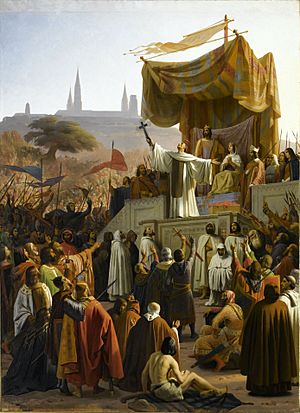
News came from the Holy Land that worried Christians. The city of Edessa had been captured by the Seljuk Turks. The Christian kingdoms there were in danger. In 1144, Pope Eugene III asked Bernard to preach the Second Crusade. He offered the same spiritual rewards as for the First Crusade.
At first, people were not very excited about this crusade. Bernard focused on how joining the crusade could help people gain forgiveness for their sins. On March 31, 1146, with King Louis VII of France present, Bernard gave a powerful speech to a huge crowd in Vézelay. People say his voice was like a "celestial organ."
When Bernard finished speaking, many people immediately wanted to join. They supposedly ran out of cloth to make crosses, which crusaders wore. Bernard is said to have torn strips from his own robe to make more crosses, and others followed his example.
Unlike the First Crusade, many kings and nobles joined this one. But even more common people joined. Bernard wrote to the pope that "Cities and castles are now empty. There is not left one man to seven women, and everywhere there are widows to still-living husbands."
Bernard then went to Germany. Many miracles were reported wherever he went, which helped his mission. Conrad III of Germany and his nephew Frederick Barbarossa also joined the crusade.
During this time, a monk named Radulphe was encouraging attacks on Jewish communities. The archbishops of Cologne and Mainz strongly opposed this and asked Bernard to stop him. Bernard did so, traveling to Germany to confront Radulphe and send him back to his monastery.
The last years of Bernard's life were sad because the Second Crusade failed. Many blamed him for its failure. Bernard felt it was his duty to explain what happened to the Pope. He wrote that the crusaders' sins were the cause of their bad luck and failures.
The Wendish Crusade (1147)
Bernard also preached the Wendish Crusade against some Western Slavs. He said the goal was to fight them until they either converted to Christianity or were defeated.
Final Years (1149–53)
Bernard saw many of his friends and important people die in his last years. This reminded him that his own end was near. He died at age sixty-three on August 20, 1153, after spending forty years as a monk. He was buried at Clairvaux Abbey. Later, his remains were moved to Troyes Cathedral.
Bernard's Teachings
Bernard was given the title "Doctor of the Church" in 1830. This means his teachings are very important to the Church. He is sometimes called "The Last of the Fathers" because he was one of the last great thinkers from the early Church period.
Bernard wrote a lot about the virginity of Mary and her role as a helper between God and people. He also wrote about the importance of sacred places and church music.
Even later religious leaders like John Calvin and Martin Luther quoted Bernard's writings.
Spirituality
Bernard helped bring back the importance of lectio divina (a way of reading the Bible slowly and prayerfully) and quiet thinking for monks. He noticed that when monks didn't practice lectio divina, their spiritual life suffered. Bernard believed that people who try to guide themselves spiritually often make mistakes.
Legacy
Bernard's ideas and his special devotion to Mary are still very important today, especially for the Cistercian and Trappist monastic orders. Bernard helped start 163 monasteries across Europe. His influence led to important changes in Church law. He was made a saint by Pope Alexander III on January 18, 1174. He is called the "Mellifluous Doctor" because of his beautiful and persuasive speaking and writing.
His feast day is celebrated on August 20 in several Christian groups.
In Dante Alighieri's famous poem, Divine Comedy, Bernard is the last guide for Dante as he travels through heaven. Dante chose Bernard because of his deep spiritual thinking, his love for Mary, and his skill with words.
The Couvent et Basilique Saint-Bernard, a group of buildings from different centuries, is dedicated to Bernard in his birthplace of Fontaine-lès-Dijon.
Hymns
Bernard of Clairvaux is believed to have written the words for several hymns that are still sung today, including:
- "O Sacred Head, Now Wounded"
- "Jesus the Very Thought of Thee"
- "Jesus, Thou Joy of Loving Hearts"
Works
Bernard wrote many important books, letters, and sermons. His writings are still studied today.
Some of his most famous works include:
- The steps of humility and pride (about being humble and avoiding pride)
- Apology to William of St. Thierry (defending the Cistercian monks)
- On loving God (about how to love God)
- In Praise of the new knighthood (about the Knights Templar)
- On consideration (advice to Pope Eugene III)
- The life and death of Saint Malachy, bishop of Ireland (a biography of his friend)
His sermons are also very well-known, especially his Sermons on the Song of Songs. He wrote 86 of these sermons but died before finishing the series. These sermons include a sad passage where he mourns the death of his brother, Gerard.
Many letters written by Bernard also still exist.
See also
Template:KIDDLE XL START  In Spanish: Bernardo de Claraval para niños Template:KIDDLE XL END
In Spanish: Bernardo de Claraval para niños Template:KIDDLE XL END
- Scholasticism
- St. Bernard de Clairvaux Church
- Prayer to the shoulder wound of Jesus
- Pope Eugene III


